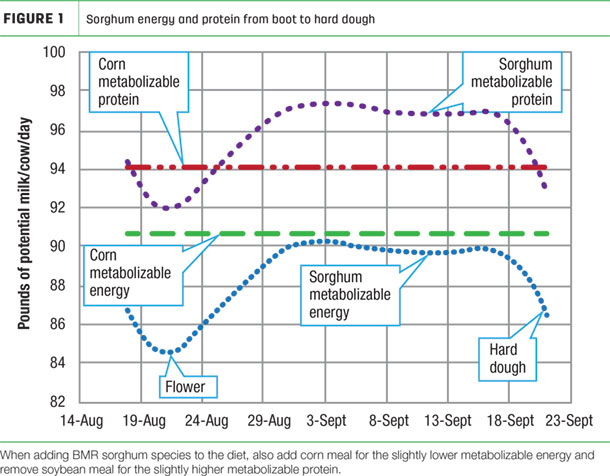Unfortunately, conditions in those regions, hot and dry, do not match the higher-moisture and colder nights (conserve digestible energy) in the Northern regions. With support from New York Farm Viability Institute (NYFVI), we embarked on comprehensive research to determine stage of harvest, harvest techniques, proper fermentation procedures and, most critical: How does it fit in dairy rations in Northern regions?
For sorghum harvest (and sorghum-sudan) we suggest one, instead of multiple, harvests. Recent work at the University of Wisconsin found a one-harvest cut yields twice as much as a multi-cut. One cut also drastically reduces the harvesting costs that can reduce profitability. Direct cutting keeps the crop out of the dirt, which keeps the milk-robbing ash level low and prevents soil contamination from interfering with proper fermentation.
If the only harvest system is round bale wrapping, then a multi-cut with a sorghum-sudan or sudangrass may be more practical. For both sorghum and one-cut sorghum-sudan, we found the rowless corn harvesters work very well. The only caution is: It is so easy to cut farmers tend to drive too fast for the head speed and so leave more of the digestible yield in the field as longer-stalk stubs.
Our multiyear replicated research found the quality change is not like winter grains or oats. Farmers think harvesting in boot stage is best; it is not. As the head comes out and starts to fill the grain, the quality continues to go up and then holds over a couple of weeks until soft dough stage starts. In Texas, they chop when soft dough (squeeze the seed, and it comes out like cooked oatmeal) is halfway down the seedhead. Our research says that is too late. Quality goes down. Potential milk decreases. The top seeds, that are now hard, are too small to process and pass through the cow undigested.
In addition, as the stalk components are cannibalized to mature the seed, the stalk quality rapidly deteriorates, and even our brachytic dwarf lodged 25 to 35 percent in one week. We suggest that as soon as the seeds on the top tip of the seedhead reach soft dough, get harvesting. There is a wide quality harvest window, but it closes abruptly if you dawdle and delay harvest. Fortunately, you can often see when driving by light tan heads in the green golden ones. These are early mature heads and usually mean you need to get harvesting ASAP.
The other major issue with sorghum species is: The crop is designed to take up and hold water. Thus, it is ready to chop before it is 30 to 35 percent dry matter. Many times, when the tip seeds reach soft dough, it will be 25 percent dry matter. We have made perfect sorghum silage at this moisture. Chopping it fine and processing it will turn the forage into the consistency of applesauce and produce hundreds of gallons of leachate which, besides making a smelly mess, removes the most digestible part of the plant. Do not process. It is a waste of fuel, time and is completely counterproductive.
With the NYFVI-funded research, we evaluated multiple cutting lengths and processing gaps. No processing and a cut length of a minimum of 3/4 inch, and preferably 1-plus inch, seemed to work best. This is a BMR fiber that breaks down readily in the rumen and could wash out before the extent of digestion needed. The longer length of cut both directly reduces the leachate and can provide more effective fiber in the rumen.
Use of a high-quality, homolactic bacteria inoculant is critical
This is a wet, very high-sugar forage. In a replicated randomized test conducted with American Farm Products, the inoculated, compared to the control, was worth 2.3 pounds of milk per cow per day more in higher preserved NDFd. In another replicated study utilizing a Chr. Hansen inoculant designed for wet, high-sugar forage, we harvested at multiple replicated points from 17 to 30 percent dry matter. No samples had any butyric acid over threshold. In fact, there was little to none detected when the forage was 25 percent dry matter or more.
There is considerable apprehension over the potential of prussic acid poisoning from sorghum species. The bottom line is: If you are feeding completely fermented forage, it does not matter when it was cut – before or after frost – the data clearly state after ensiling it is no danger to animals. Prussic acid rapidly dissipates from ruptured cells and is quickly lost. The only potential problems are in grazing or chopping and leaving a load overnight to feed the next morning. Under certain conditions, nitrate can and will be an issue. Prior forage tests for nitrate can give you a clear guideline.
The rubber hits the road when we feed it to the cows. It is not corn silage. Simply pulling out corn silage and adding sorghum is a prescription for disaster. With key help from Cornell Professor Emeritus Dr. Larry Chase, using the Cornell Net Carbohydrate and Protein System 7.0, we tested the means of replicated samples taken each week from boot stage to hard dough stage. He had to make multiple adjustments in NDF intake and concentrate as he switched from one forage to another.
On gross terms, adding BMR sorghum species to the diet, you will need to add some corn meal for the slightly lower metabolizable energy and remove some soybean meal for the slightly higher metabolizable protein (Figure 1).

This result is very similar to a feeding trial Dr. Rick Grant of the William H. Miner Agricultural Institute completed with sorghum-sudan in the 1990s. He also reported higher rumen pH and higher components, yet got the same fat-corrected milk. One place it shines is as a higher-yielding, lower-cost forage to raise replacement animals.
Sorghum is not a magic crop. I have seen success in dairy rations and failures. The nutritionist plays a key role to adjust for this very different forage. Fortunately, the NYFVI-backed research and Dr. Chase’s expertise gives us clear parameters for when and how to harvest, the critical role of inoculant and how to optimize its use in a dairy ration. Sorghum is a crop for Northeast farmers to consider. In these tight economic times, it is one more way to reduce the cost of digestible forage that reaches the mouth of the cow. ![]()
Tom Kilcer is a former Cornell Cooperative Extension program leader and is a private consultant with Advanced Ag Systems. Email Tom Kilcer.






